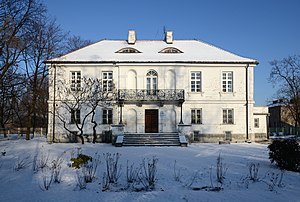Wierzbicki Palace
| Wierzbicki Palace | ||
|---|---|---|
|
Main facade |
||
| Creation time : | 1830 | |
| Castle type : | Palace | |
| Conservation status: | Reconstructed | |
| Place: | Warsaw | |
| Geographical location | 52 ° 14 '30 " N , 21 ° 6' 47" E | |
|
|
||
The Wierzbicki Palace , also known as the Grochowski Manor or Palais des Prince Michał Poniatowski (Polish: Dworek Grochowski or Dwór księcia Michała Poniatowskiego ) is located at 64 Grochowska Street in the Praga Południe district of Warsaw . The listed building was built as a smaller classical style residence and is now used as the seat of a music school.
history
The history of the building is not clear. It is certain that the Swede Karl Osterhof had the current residence built at the end of the 1830s. In 1835 he had acquired part of the former Grochów estate and set up a beer brewery, a sparkling wine factory and a schnapps distillery there. From 1915 to 1918 there was a school here where Pola Gojawiczyńska taught. Methodists ran an orphanage here from 1818 .
In 1924 the politician and industrialist Andrzej Wierzbicki acquired the palace and had it completely renovated from 1925 to 1927 based on a design by Zdisław Kalinowski and Maksymilian Goldberg. It remained in the possession of the Wierzbicki family until 1939. During the Second World War it was only slightly damaged and devastated. The renovation took place in 1956; today it serves as the seat of a state music school ( Państwowa Szkoła Muzyczna I st. nr 3 im. Juliusza Zarębskiego ).
Controversial building history
It is possible that the palace built by Osterhoff is based on an older building. It could have been a single-storey country house that was built here in the 1770s by the politician and Polish primate Michał Jerzy Poniatowski and was extended or rebuilt several times until the 1810s (the builder Friedrich Albert Lessel may also have been involved involved).
Legend
The building is said to have served as the headquarters of General Józef Chłopicki in the costly Battle of Grochów during the November Uprising . Even if cannon balls built into the wall of the building and the name of the access road ( Ulica Kwatery Głównej ; German: Street of the Headquarters ) suggest this connection, it is still not verifiable. Based on the assumption that the palace was Chłopicki's headquarters, Stanisław Wyspiański's play “Warszawianka” (German: “The Warschauerin”) performed in 1898 and dedicated to the insurgents takes place in this palace.
Location and architecture
The palace is located on the right bank of the Vistula about 5 kilometers (as the crow flies) from downtown Warsaw, about 200 meters north of the heavily trafficked Grochowska Street and east of the city park Colonel Jan Szypowski "Leśnik" (Polish Park miejski im. Płk. Jana Szypowskiego "Leśnika" ). It is a modest building with elements of the Renaissance style, surrounded by a park-like garden of around 4,000 square meters . There are two floors with a covered hipped roof above a half-ground floor . Access to the site is via the narrow ulica Kwatery Głownej , to which the building stands at right angles. The entrance to the palace is now on the narrow east facade. Here a small, single-storey vestibule was added to the otherwise square palace. The longitudinal facades each have a subtle central projection ; On the south side of this risalit there is an exit with a flight of stairs to the current garden. A balcony on the first floor, which is provided with a wrought-iron grille in a baroque design, was installed over the entire width of the risalit . The roof was removed on the more unadorned north side - probably only after the war - and provided with a window ledge.
See also
literature
- Julius A. Chroscicki and Andrzej Rottermund: Architectural Atlas of Warsaw. 1st edition, Arkady, Warsaw 1978, p. 67
- Tadeusz S. Jaroszewski: Palaces and Residences in Warsaw. Interpress publishing house, ISBN 83-223-2049-3 , Warsaw 1985, p. 170 ff.
Web links
- To the palace in the Warszawa Wiki (in Polish)
- Information about the manor on the Praga Południe district website (in Polish)
References and comments
- ↑ Pola Gojawiczyńska (1896-1963) was a Polish poet
- ^ Andrzej Wierzbicki (1877–1961) was a Polish entrepreneur and minister
- ^ Maksymilian Goldberg (1895–1942) was a Polish architect
- ↑ Michał Jerzy Poniatowski (1736–1794) was a Polish secretary to the grand crown, bishop and primate of the country
- ↑ Presumably these balls were walled in by Wierzbicki
- ↑ Chłopicki's headquarters were probably located in a wooden mansion on the opposite side of today's Grochowska Street, which no longer exists





